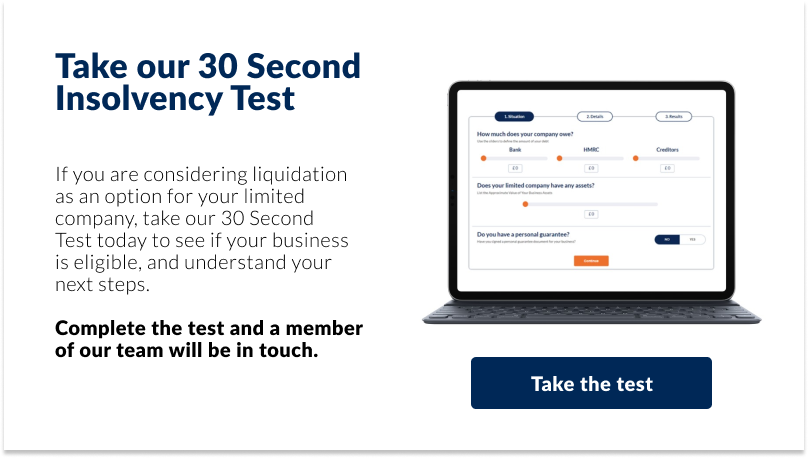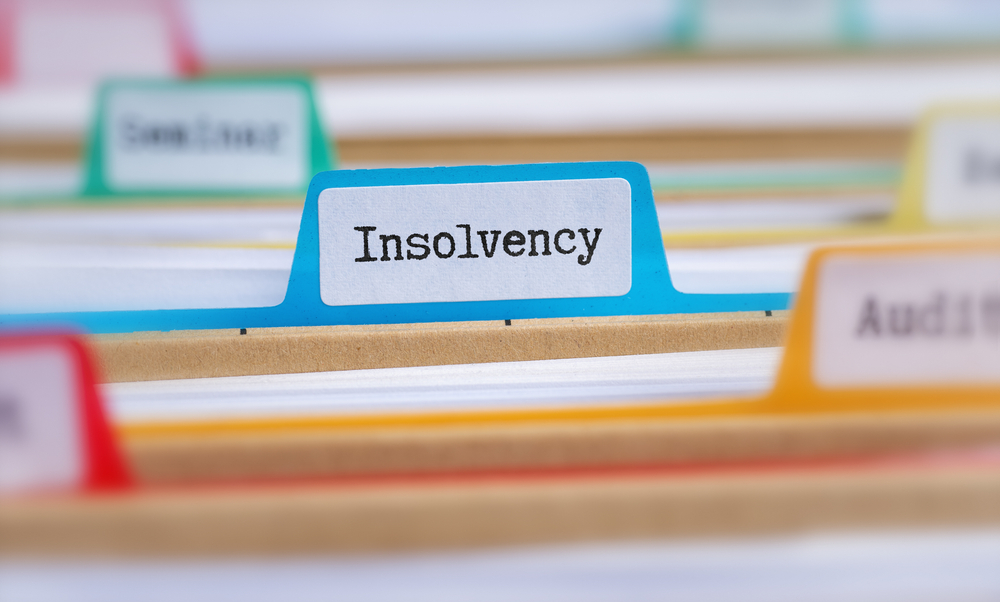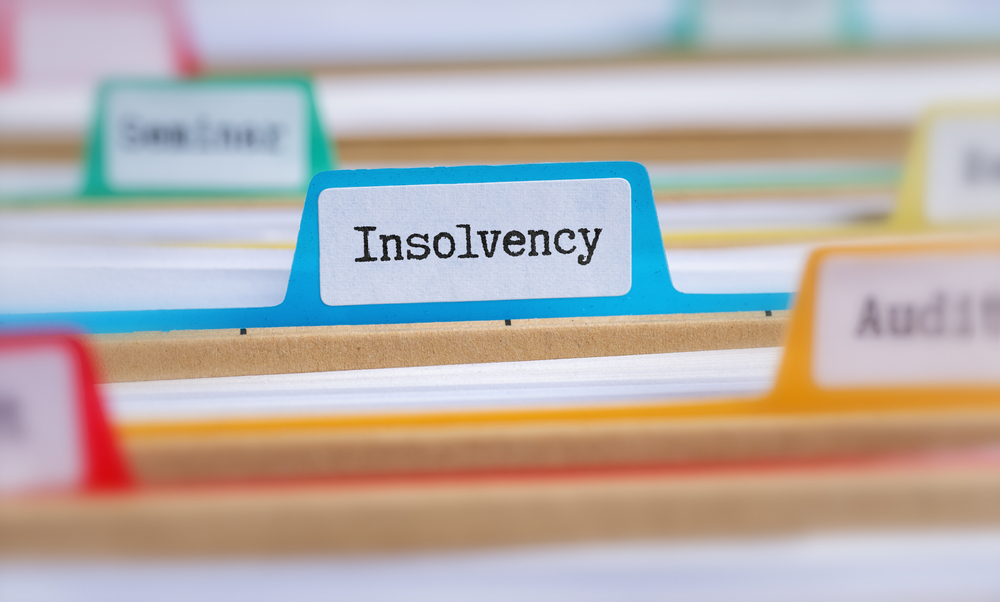
What is the Corporate Insolvency Test for a Limited Company?
Why Test for Insolvency?
When a limited company encounters financial distress, insolvency tests help determine whether it has reached a threshold at which the directors’ fiduciary duties undergo a significant legal shift.
Providing clear, objective evidence of a company’s financial status, these tests help directors establish the ‘tipping point’ when their primary duty shifts from acting in the company’s interests to prioritising creditors.
Without these tests, directors may inadvertently continue trading while insolvent, potentially exposing themselves to personal liability.
>>Read more about your duties as a company director

Three Tests of Company Insolvency in the UK
The 3 checks that the insolvency test covers are as follows:
| Test | Purpose |
|---|---|
| Cash-Flow Test | Assesses if a business can pay its bills on time, now and in the near future. |
| Balance Sheet Test | Compares the total value of assets to liabilities to determine solvency. |
| Legal Action Test | Evaluates if a company faces legal actions due to unpaid debts. |
Cash-flow Test
The cash flow test focuses on a company’s ability to pay debts as they fall due.
The legal basis is established in Section 123(1)(e) of the Insolvency Act 1986[1]Trusted Source – legislation.gov.uk – Section 123(1)(e) of the Insolvency Act 1986, which deems a company insolvent if ‘it is proved to the satisfaction of the court that the company is unable to pay its debts as they fall due’.
To perform a cash-flow insolvency test, you need to:
- Estimate future cash inflows and outflows for a near-term period.
- Check if the business has enough cash to cover its short-term liabilities.
For example: A business forecasts a cash surplus of £20,000 over the next three months. Its short-term liabilities are £15,000, so the business has sufficient liquidity to meet its immediate financial obligations.
Balance Sheet Test
Addressed by Section 123(2) of the Insolvency Act 1986[2]Trusted Source – legislation.gov.uk – Section 123(2) of the Insolvency Act 1986, The Balance Sheet test involves comparing the total value of a business’s assets (including cash) to its liabilities. If the assets are less than the liabilities, the business is likely insolvent.
This test requires accurate financial records and often involves working with an accountant to ensure all values are correctly represented.
For example, if a company has £1 million in loans and bills (liabilities) but only £800,000 in inventory and equipment (assets), it may be insolvent.
Legal Action Test
The legal action test assesses if a company faces formal challenges from creditors, such as statutory demands or County Court Judgments (CCJs).
Failing this test, particularly if unable to settle a debt over £750, is critical as it can lead to a winding-up petition. A winding-up petition is a serious threat to a company’s existence, as it can result in compulsory liquidation if successful.
Example: LMN Ltd owes £500,000 to a supplier who has issued a statutory demand for payment. The company has been unable to pay the supplier and has not reached a payment agreement with them.
In this case, the legal action insolvency test would apply. Under UK law, a company is presumed to be insolvent if it fails to pay a statutory demand within 21 days. This means that the supplier could potentially apply to wind up LMN Ltd in court.
What to Do if Your Company is Insolvent
If your business is facing financial difficulties, it’s crucial to explore all available options to address debt and avoid insolvency. Taking early action can make a significant difference in the outcome for your company.
- Seek Professional Advice: Contact a licensed insolvency practitioner (IP) to discuss your situation. We can offer expert guidance on the best course of action tailored to your company’s specific circumstances.
- Company Voluntary Arrangement (CVA): This is an agreement with your creditors to pay debts over time. CVAs can offer a flexible way to repay while continuing your business operations.
- Administration: This option provides protection from creditors while a plan is developed to pay debts, sell assets, or find a suitable way to rescue the business.
- Liquidation: If your business cannot be saved, liquidation involves selling assets to pay off debts before closing the company. This is often seen as a last resort.
How Company Debt Can Help
If your company is facing financial difficulties, Company Debt has a team of experienced insolvency practitioners ready to assist. Whether you need advice on rescuing your business or are considering the possibility of closing it down, our licensed professionals can provide the support and guidance you need. We offer free, no-obligation consultations to help you explore your options and make informed decisions to address your company’s financial challenges.
For more information or to discuss your options, contact us at 0800 074 6757, email info@companydebt.com, or use our live chat feature.
FAQs on the Corporate Insolvency Test
Can a company still be considered solvent if it fails one of the insolvency tests?
Yes, a company may still be considered solvent if it fails one test but passes another. For example, a company might fail the balance sheet test but still meet its cash flow obligations. However, failing any test should prompt a thorough review of the company’s financial situation.
What are contingent liabilities, and how do they affect the balance sheet test?
Contingent liabilities are potential obligations that may arise depending on the outcome of a future event. They must be considered during the balance sheet test because they can significantly impact a company’s solvency status if they become actual liabilities.
Are there any exceptions where a company with more liabilities than assets might not be considered insolvent?
Yes, certain companies with long-term projects or significant investments in assets that are not immediately liquid may not be considered insolvent if they can still meet their short-term obligations and have future income prospects.
The primary sources for this article are listed below, including the relevant laws and Acts which provide their legal basis.
You can learn more about our standards for producing accurate, unbiased content in our editorial policy here.
- Trusted Source – legislation.gov.uk – Section 123(1)(e) of the Insolvency Act 1986
- Trusted Source – legislation.gov.uk – Section 123(2) of the Insolvency Act 1986








